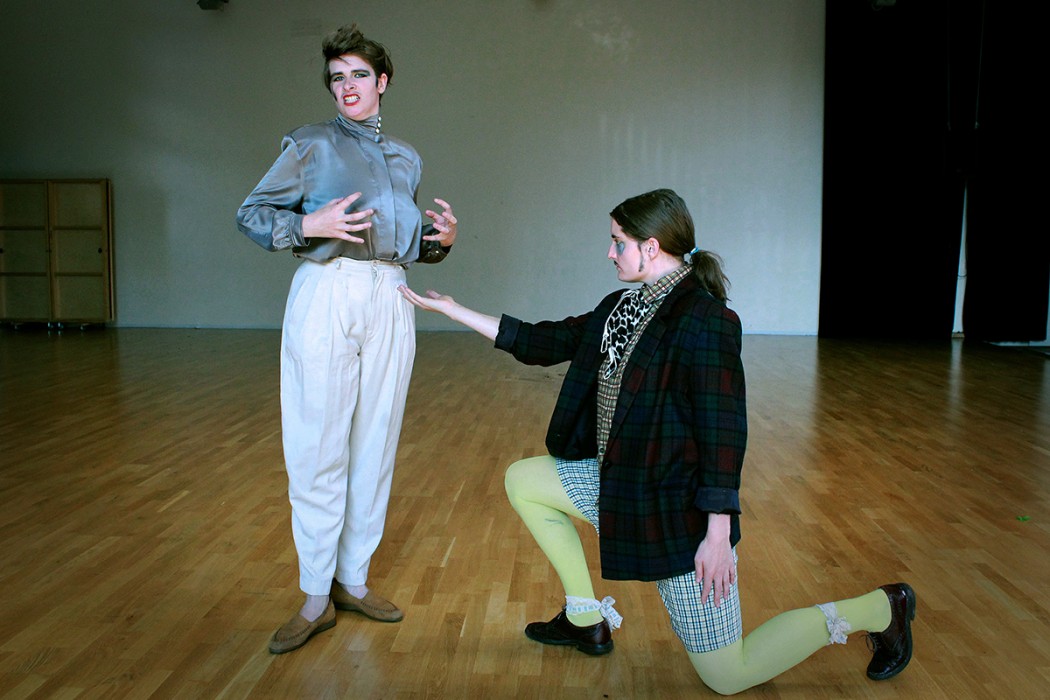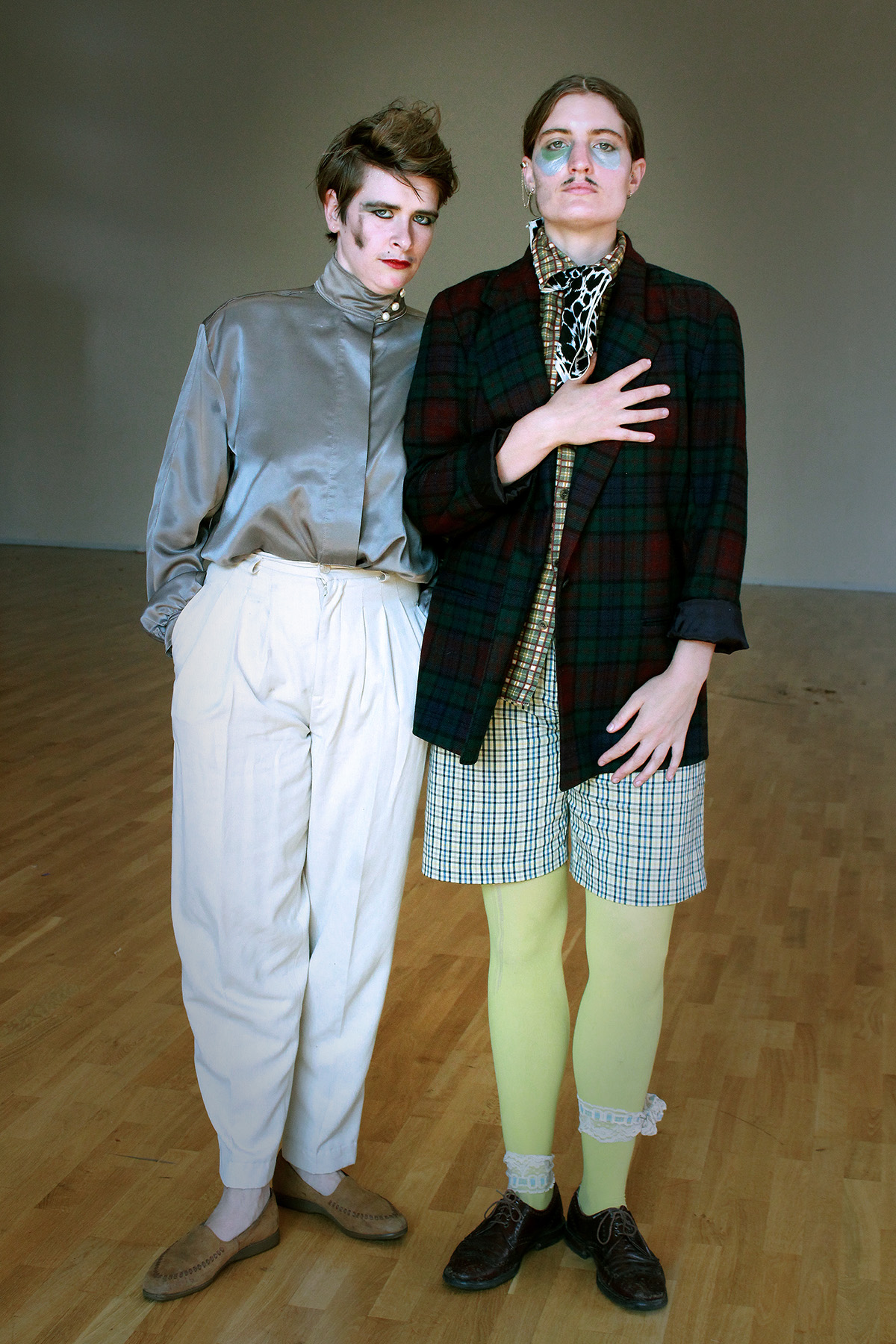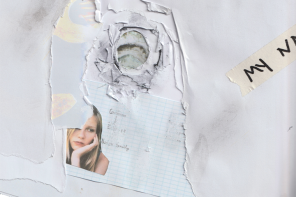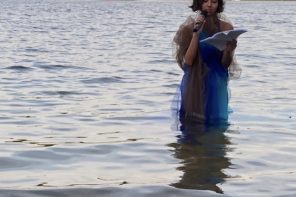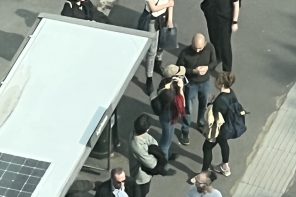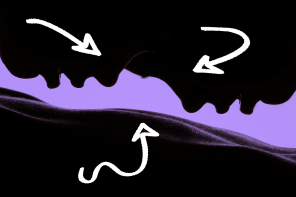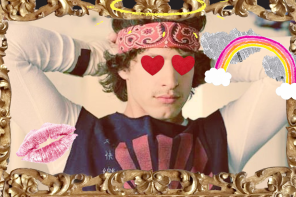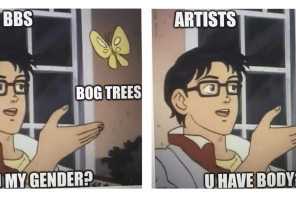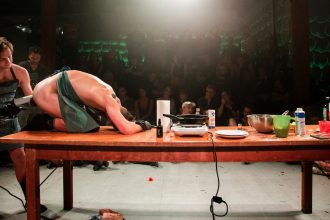I set out to interview Steve and Sam, the sexiest and cleverest drag-kings I have ever seen. Unfortunately, they are also the only drag-kings I have ever seen. Why so rare? I wanted to understand Steve and Sam better, how they work, and what they are like as people within “characters”. My plan was to devise an MTV interview of sorts, and interview Steve and Sam. We met on a warm day to discuss my proposal in the dappled hof behind RUG—a four-month-old dance space in Berlin’s Wedding.
Over spätkauf beers, it immediately became clear that Zinzi Buchanan and Sheena McGrandles were not interested in dressing up and explaining what Steve and Sam were all about. These are not “characters” and they are not “acting”. I stood corrected and informed, gladly. An organic conversation about the work ensued.
Louise : So if you can’t act, what would you say that you’re doing when you’re on stage as Steve?
Zinzi: I think I work really similarly as Steve as I would as Zinzi, in that I’m feeling and sensing a lot, and the foundation of what I do comes from this sensation. But as Steve, I also understand that I’m read as male or ambiguous, and I also do gestures that would be understood as macho, but I don’t represent them… Or I wait until I feel something in them. So we did “put your elbow on things”, which was a space-taking exercise.
Sheena: But for me it’s not about representation, it’s more about certain codes, how these codes play out, and how we can start to disrupt those and play with them, and how an elbow is a reference to this idea of taking space. It also becomes an object of relation and how that can potentially amplify or rupture our performance of masculinity. Or the thrusts we were working with. We recognize certain codes or attributes to masculinity, and we work with those in order to transform them.
Z: But they don’t really come up like that. They don’t come through us thinking, “oh, what are these codes of masculinity?” They often come up playfully–let’s just put our elbow on things and see what happens. So there’s this impulsive way of making things that’s not about constructing something.
L: So, when you’re in that moment when you’re deciding what to do, and you decide to put your elbow on things, are you inspiring yourself from the masculine gestures that you see in the world? Or are you just spontaneously being abstract?
S: I think you can’t avoid [masculine gestures]. We’re very accustomed. They’re every day. It’s in our social language and it’s borderline between parody and being critical, and this is something I think we’re dealing with, or that we’re aware of through what we’re doing.
Z: Also, actually putting your elbow on things doesn’t have to mean anything in particular. So the simplicity of this gesture means that you can go from being something that you read as masculine to being something that is just…
S: A gesture?
Z: That is obsolete. And depending on the physicality, the relationship you have with another body, or even to yourself, whether you’re opening your body up to putting your elbow on something, or closing your body in, there is distance also… these simple things can shift through a tiny shift in your physicality or a shift in the relationship to your own elbow, or the thing you have your elbow on.
L: So how much does the context play into your decision-making process? You say that a gesture doesn’t have to be something that signifies or comes from something specific. It doesn’t have to be a masculine gesture, it just has to be simple. So when you are choosing to do something in a performance, are you interested in the juxtaposition between the context of you being in drag, and then you being in the world, and you being spatially aware, and the gesture?
S: I think it has many different levels. It goes back to the question of visibility of female masculinity, drag work. How that’s happening and where that’s happening. I feel it’s important for us as artists and us as Steve and Sam… it think there’s a desire to gain visibility through this work, also as a means to raise questions around the female as an artist. It becomes then an interesting mix to put these things together and also see how that’s panning out.
Z: I was just thinking, in terms of context, I’ve found from doing these explorations, not just the drag shows themselves, but from doing explorations, that I interact in a different way with the world. I could say that I have a more masculine physicality when I’ve been working with this in the studio, or with Sheena. The context becomes blurry.
L: So, you’re saying on the one hand you don’t feel like you’re representing anything, but that through these explorations you develop a more masculine physicality. Maybe my question is; what’s your relationship to masculinity and what is interesting to you about it? Is it interesting for you to complicate it? Is it interesting to embody it? To see what it’s like? Or when you’re exploring, are you even thinking about it?
Z: Um, I think I’m interested in complicating gender assumptions in general. And through Sheena’s guidance I found a masculine body and I found what it was to go to more of an extreme in terms of looking and performing masculinity. Because I was really resistant to this, I really didn’t want to do it. But feeling things is, somehow, believing things. Understanding what it is to have a hard body, how it is to be in the world with a hard body… It’s super empowering! But I don’t know if that’s just because of how masculinity is constructed as being powerful and dominant, or whether it is actually just the way in which I interact with objects. I dunno, I go to a restaurant and I sit down and I have a wider stance, I’m more secure. I’m operating in a different way.
L: This is as Zinzi?
Z: Yes, as Zinzi. But then, for me, it’s also about complicating my own assumptions about my own gender expression. And that it fluctuates, I’m not one form of expression; I’m not clear and defined. This is also about being perceived. Actually, the reason I started getting interested in gender, reading and talking about it, was because I really didn’t like being read as female, just because of witnessing power structures in the world.
L: It’s interesting what you said, to feel something is to believe it, and having a wider spectrum of things to feel. Its also interesting because it’s like saying there is a wider spectrum of things to believe… I don’t know. Just a thought.
Z: Yeah I think they’re really parallel. You know, a flexible mind is a flexible body, and the other way around as well.
[…]
Z: We do lots of touching and we work with other bodies, like fruits and vegetables. I started doing that with Steve, before Steve and Sam became a unit. This was my way of renaming things. So I would talk about things, and they weren’t actually what they were. I would project my desire onto objects.
L: Can you give an example?
Z: So, I mean I’ve worked with this for a while, but like, feeling the density of things, feeling how the touch can be something that gives life to an object, but also can obscure it or destroy it. It’s not totally clear for me why I worked with fruits or vegetables initially. I guess their associations, like a banana is phallic, and other fruits like the papaya or the avocado are vaginal. I would also talk. So I would pick up the fruits, and I would talk about the fruits, and it was about trying to create a mess and mixing them. And I would have this dialogue, which was like a metaphor for sexuality, which, if I think about it, is kind of funny.
S: There’s a real erotics in this for me. I think this is where I find the crossover with what Zinzi is bringing in: objects and sensation. I think there’s a lot of pleasure in the potentiality of the erotics in relation to the body and touch, and the triangle in between. This is where I think about the insertion of female in masculinity, or female masculinity, and this is something that we bring to masculinity as opposed to masculinity being the thing.
L: And it happens through the touch?
S: Yeah, and this is something I’m interested in in what we’re doing. And it also manifests itself physically. I think [touch] is a very feminine principle to work with. It’s what makes our work not so stereotypically drag-king based. This [stereotype] is something we are constantly trying to walk away from, as in not working with mime or not working in these very clear performance strategies that we see being re-adapted within the showing room.
[…]
L: Can we talk about humor? Like when I see your performances I’m expecting to laugh, and I do laugh, a lot, so I wanted to ask about the use of humor. The feminine, the female, being funny on stage, or just how your feminine identities contribute to the use of humor, vs. other drag queen identities…
Z: There is something about exposing these gender constructs, and ridiculing them in some ways. That’s why it’s so funny. When you see an extreme version of masculinity it’s like, “this is so absurd”, and when you see it in a stage context, I think that can be something that tickles people.
[…]
L: So, you’ve been working in queer spaces, clubs and bars and stuff and now you want to invade the world of dance and performance. Does that require grant writing?
S: It’s a big financial question. What I enjoy about the work so far is that it doesn’t have the pressure of money. I think you make things very differently with or without money. But I would like to push for a project we will be writing for in October, and we need to figure it out whether it’s with or without money.
L: What do you think about the transition from low-tech/low-budget to more money/more tech?
S: I think it has to stay low-tech. One way of working with no money or thinking about conditions that support that, is to also develop the format of the warm-up act, 15-20 minutes, wamm bamm thank you mam. And in parallel, we are also thinking of more durational work.
L: And if you were to go site-specific?
Z: We have a project we want to do. We want to build a wall.
S: Yeah. Steve and Sam build a wall. Coming soon.
Z: Like a brick wall.
S: Yes, we literally want to build a wall over days.
S: And we’re asking for visibility, and giving it to ourselves. It’s all about that. We’re here. We’re….
[laughs]
Interview by Louise Trueheart
Photography by Judy Mièl

